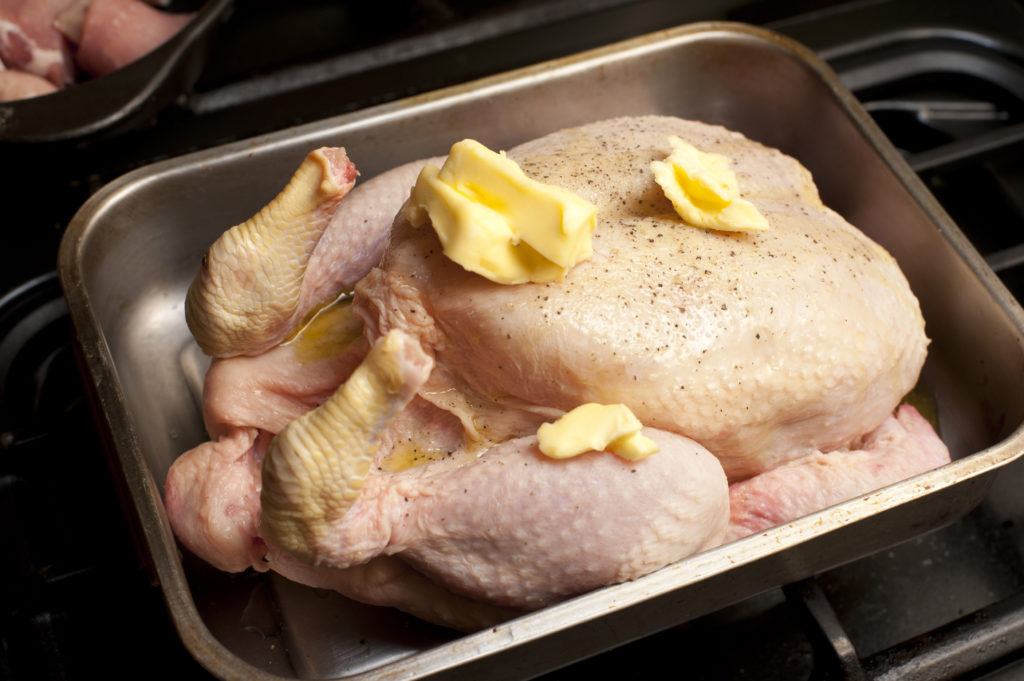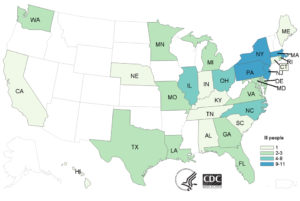All fields are required
Posted in Outbreaks & Recalls,Salmonella on October 18, 2018

A devastating outbreak of Salmonella is currently spreading quickly throughout the United States. This multistate outbreak is made even more deadly given that the Salmonella Infantis is multidrug-resistant. Investigators from the Center for Disease Control (CDC) are linking the outbreak to raw chicken products from a variety of sources with no single common supplier being identified. 92 people have been affected from 29 states. Further, there have been 21 hospitalizations. Stakeholders are currently trying to get the situation under control with U.S. Department of Agriculture’s Food Safety and Inspection Service (USDA-FSIS) monitoring the outbreak. Unfortunately for food safety observers, this is yet another yet another poultry-related outbreak to add to the long list of cases in recent history. Here is everything you need to know about this latest Salmonella Raw Chicken Outbreak.
First, a clarification of what is known by the authorities must be given. Illnesses started from January 19, 2018, to September 9, 2018. CDC has been extremely thorough in their investigation to date with a comprehensive PulseNet system being used to monitor the illnesses attributed to the outbreak. There is a phenomenal range of people affected with ill people ranging in age from less than one year to 105, with a median age of 36. Additionality, sixty-nine percent of ill people are female thus showing the gender bias for victims. This information illustrates to food safety professionals just how encompassing this Salmonella outbreak is for consumers and the subsequent dangers to health. Investigations have shown the strain in samples from a variety of raw chicken products including pet food, chicken pieces, ground pieces and whole chickens. The bacteria have also been found in live chickens.
Interviews are an indispensable tool for investigators to coherently analyze the perilous situation. Ill people were posed questions focusing on the weeks before they came ill, especially about the foods they ate and other exposures. Of 54 people interviewed, 48 (89 percent) reported preparing or eating chicken products that were purchased raw, including whole chicken, chicken pieces and ground chicken. Results conclusively prove that this outbreak caused people to get sick from handling or eating raw or undercooked chicken as ill people reported purchasing various different brands of raw chicken products from many stores. The patients live in California, Washington, Texas, Nebraska, Missouri, Minnesota, Illinois, Indiana, Michigan, Ohio, Kentucky, Tennessee, Alabama, Louisiana, Georgia, Florida, South Carolina, North Carolina, Virginia, Maryland, Delaware, Pennsylvania, New Jersey, New York, Connecticut, Rhode Island, Hawaii, Massachusetts and Maine.

Photo courtesy of CDC
Rosa DeLauro (D., Ct.) believes that; “The overuse of antibiotics in the livestock sector only makes this problem worse, and it is long past time we deal with the problem head-on, instead of going through the same issues over and over again. The federal government and the poultry industry need to take this problem seriously. Déjà vu (after a similar incident of antibiotic-resistant strain of salmonella that contaminated chicken five years ago which resulted in 634 illnesses across 29 state) is not an acceptable policy for dealing with food safety. We need to be proactive. People’s lives are on the line”.
Investigators have identified the outbreak strain of Salmonella Infantis through sampling raw chicken pet food, from raw chicken products from 58 slaughter and/or processing establishments, and from live chickens. These samples were collected at slaughter and processing establishments to assist FSIS’ routine testing under the Salmonella performance standards. Furthermore, Whole Genome Sequencing (WGS) showed that the Salmonella from these samples is closely related genetically to the Salmonella from ill people. The CDC in their investigation notice state that; “a single, common supplier of raw chicken products or of live chickens has not been identified. The outbreak strain of Salmonella Infantis is present in live chickens and in many types of raw chicken products, indicating it might be widespread in the chicken industry. CDC and USDA-FSIS have shared this information with representatives from the chicken industry and asked about steps that they may be taking to reduce salmonella contamination.”
This outbreak of Salmonella is alarming stakeholders given that it is multidrug resistant, especially the following antibiotics (the main drug used to treat the disease): ampicillin, ceftriaxone, chloramphenicol, ciprofloxacin, fosfomycin, gentamicin, hygromycin, kanamycin, nalidixic acid, streptomycin, sulfamethoxazole, tetracycline, and trimethoprim-sulfamethoxazole. These results of predicted resistance came from WGS analysis of isolates from 43 ill people and 68 food or environmental samples. Moving forward, CDC and USDA-FSIS are sharing information about the investigation with representatives from the chicken industry seeking to establish precautionary measures to reduce Salmonella contamination.
Salmonella is becoming an all too familiar illness in the U.S. Common symptoms usually occur 12 to 72 hours after being exposed with infections including diarrhea, fever and stomach cramps. Children under the age of 5, adults over 65 years old and people with weakened immune systems are more likely to suffer severe Salmonella upon infection. The illness usually lasts between four and seven days with most healthy people recovering without ever needing treatment. with antibiotics. Cases that cause concern include severe diarrhea and a spread from the intestines to the bloodstream. However, there are reported cases of death unless victims are not treated promptly.
There are several easy, vital safety procedures that must be adopted to prevent Salmonella infection. Most importantly, it is paramount that the handling of raw chicken is done carefully given that raw chicken has harmful germs that can infect food preparation areas. Hands should always be washed thoroughly, especially before and after preparing or eating food, touching animals, or using the toilet.
Raw chicken should not contaminate the food preparation areas as germs can spread to other foods and surface. A separate cutting board for raw chicken and vegetables will efficiently manage germs and protect diners. It is a good idea to not wash chicken before preparing it. Another fundamental step to avoid Salmonella infection is thoroughly cooking raw chicken to kill harmful germs. Purchasing a food thermometer to effectively measure temperatures is a proactive way of ensuring food safety. Chicken breasts, whole chickens and ground poultry should always be cooked to an internal temperature of 165°F.
By: Billy Rayfield, Contributing Writer (Non-Lawyer)